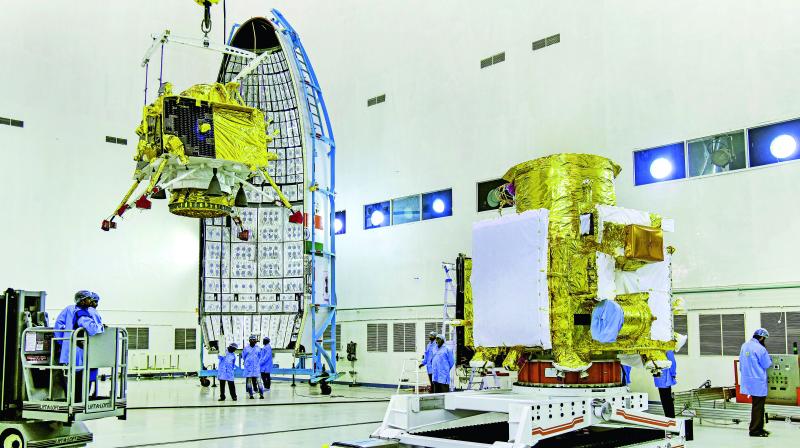India’s big leap to moon

After finding evidence of water on the moon and launching a satellite in the Martian orbit, India is undertaking another difficult mission of sending its probe to the moon’s southern polar region, which is the first-ever attempt by any country.
For many Indian space scientists, the coincidence is fairy tale! As students, they were glued to the radio for updates on Apollo 11, perched on Saturn V rocket at the Kennedy Space Centre on Merritt Island, Florida. Fifty years later (Saturn V blasted off with Apollo 11 on July 16, 1969), they gaze int-ently at their consoles, checking out scores of links and communications systems of Chandrayaan-2, India’s second shot at the Moon, which will be transported into space by the country’s most powerful rocket, from Satish Dhawan Space Centre, Srihari-kota Range, on July 15. And, if all goes well, this orbiter-lander-rover mission could provide leads on the ideal landing place for crews in future, and perhaps the setting up of a lunar station to help peer deep into the universe, or a refuelling stop for voyages to Mars and other planets. “Something new will be discovered, but we cannot prefigure the results,” says Dr V. Adimurthy, chairman of Isro’s study team on Solar System exploration, adding that the spot for landing, the South Pole region or ‘far side’ of the Moon, was picked as none has ventured to explore this territory.
Besides picking an uncharted territory, Indian space scientists will get up close with the Moon through a lander ‘Vikram’ and a rover ‘Pragyan’ though the man at the helm, Dr K. Sivan, feels the operation for landing on lunar surface will be “the most terrifying 15 minutes” as the space agency has never embarked on such a complex mission.
The results at the end of the nerve-racking manoeuvre, when the lander and the rover separate from the orbiter and glide and touch down on the Moon in early September, will be manifold: clues to many mysteries of about birth and expansion of the universe, entry of India into a consortium of space-faring nations for future inter-planetary exploration and colonisation of Moon and Mars, promote new geo-political equations, and help secure more contracts for manufacture and launch of satellites owing to Isro’s low-cost approach in exploration of space. In short, it will be a “fantastic mission” as it will also inspire more young men and women to take up research in frontier areas of astronomy, says former Chairman of Isro, G. Madhavan Nair, who steered Chandrayaan-1, a probe which did not last a year, but helped discover water on the Moon in 2008.
Like in the past, Indian space scientists are working with modest budget to accomplish a challenging task like landing on the Moon. In all, Isro will incur an expenditure of $141 million (Rs 978 crore) for the orbiter-lander-rover mission’s manufacture and a 3,84,400 km voyage before arriving at its destination. In comparison, China spent $180 million on the Chang’e programme, and the US, a whopping $25 billion on 15 Apollo missions on the Moon.
And the expertise and experience gained through Chandr-ayaan-2 will be used for future exploratory projects: A second visit to Mars in a couple of years, and subsequent launch of a probe to Venus. “We are not just set to join a small group of nations which have embarked on such ambitious exploration of space, but will foster a new age of discovery and increase our understanding of space by expanding on data thrown up by Chandrayaan-1. This mission will also stimulate advancements in technology which are essential for human habitations on the Moon,” says Dr K. Kasturi-rangan, former chairman, Isro.
In addition to the likely flow of a slew of new scientific details of much interest to astronomers and planetary research groups, cutting edge technologies developed at Isro for Chandrayaan-2 will be passed on to India Inc.
The spin-offs? “I guess we will discover them in due course just as our communication and remote sensing satellites are helping in distance education, medicine, and planning of urban areas,” adds Dr Adimurthy.
The second outing to the Moon will also benefit the defence sector in terms of new materials, technologies and networks developed for the mission, but none in Isro will venture to comment on strategic implications. For now, it’s the challenge of visiting the Moon during the 50th anniversary of Neil Armstrong’s legendry “One small step for man, one giant leap for mankind.”

